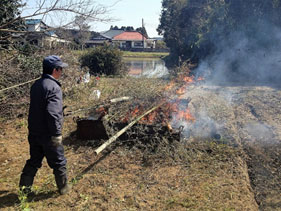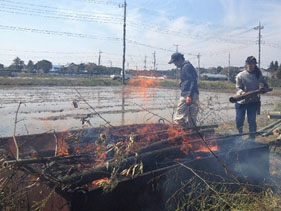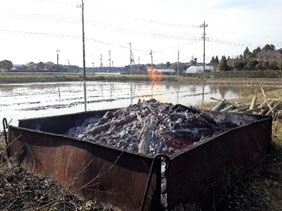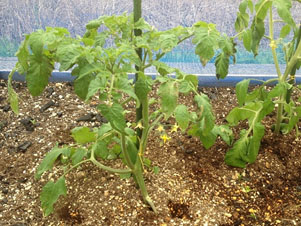Making Bamboo Charcoal
I was recently invited by a friend and member of Isumi’s takezumi kenkyūkai (bamboo charcoal research group) to help out in the making of a batch of bamboo charcoal. Having never previously had the opportunity to see how it is produced, though having sampled many delicious foods grilled over it (yakitori, for example), I leapt at the chance. And so, with clothes that I could stand to see get filthy, a pair of thick gloves and a towel, two weeks ago I set off to a property hidden within a deep thicket of that most-impressive of grasses*1.
The takezumi kenkyūkai functions in and around Isumi. The group provides assistance to those in the area who wish to clear land that has become overgrown and unmanageable due to fast-growing and difficult to control bamboo. Members and volunteers meet to cooperatively cut down the bamboo, gather it and burn it in order to produce the useful resource. This is an especially valuable service inland, where many older residents may find cutting back vegetation encroaching on otherwise useful property particularly difficult. The charcoal itself can then be used as an ideal fuel when cooking over a grill or have its nutrient-rich qualities exploited as a soil additive by gardeners and farmers alike.
When I arrived at the property being cleared, I was met by my friend and several of the organization’s other participants. They had been at work for much of the day and had cut and gathered what seemed like a huge quantity of bamboo into several piles. Still, there was a lot still to do, with many plants with stems thicker than my leg and standing several meters high waiting to be harvested.
When collecting bamboo, it is necessary to be aware that doing so presents several potential hazards. Stems tend to grow very close to their neighbors and this can result in them being under a great deal of tension. Cutting a stem that was forced to bend even slightly as it grew might result in it springing away dangerously at the stump when cut – so stand well back! Splinters from bamboo also seem to have a special knack for causing scratches – so consider protective eyewear! A final note of caution, gleaned from painful, personal experience, is that the stumps of bamboo are excellent for tripping people up – so watch where you tread! Until all of the stumps have been removed or decayed, crossing a former bamboo grove may mean hopping around like Indiana Jones avoiding boobytraps. On this particular day, I made it home with only a mildly grazed knee after tumbling forward thanks to one of them.

The beginnings of the bonfire
Once a sufficient amount of bamboo had been gathered to make a batch of charcoal, my friend set about lighting a fire within a pit created with metal plates. Starting with the driest and slenderest of the bamboo, it was not long before the flames were raging while we placed more and more of the material on at a faster and faster rate. I was shocked by the heat it produced and the speed at which the bamboo burned. Sudden changes in wind direction caused the flames to leap this way and that, and would likely have resulted in singed eyebrows had we not all been very careful. We tore through the piles incredibly quickly as a lot of hard work went literally up in smoke.

This picture doesn’t give an accurate enough impression of the heat of the fire!
Unlike other methods of producing charcoal with which I am more familiar, that require the careful stacking and burning of wood over many hours, it was barely two hours before we had exhausted our stockpile and much of the bamboo had burned down to a size sufficient to be collected. Before that could be done, however, it was necessary to extinguish the fire and rapidly cool the charcoal to prevent it breaking down any further. This is done by spraying a great deal of water onto the bonfire using a pump, a procedure that results in an incredible amount of steam and really something to behold! Everything went white briefly as we were enveloped in a great cloud, making the rush to turn the burned wood with long-handled shovels (necessary to ensure all of the precious charcoal is extinguished and made ready for bagging) all the more exciting.

At this stage the fire is ready to be doused
At the end of the day, in spite of my amateur attempts at lending a hand, I was lucky enough to head home with an informative and enjoyable experience under my belt, some new acquaintances, more exercise than I have had in a long time and a bag of freshly-made bamboo charcoal to use in my garden. I can’t wait to see how this year’s tomatoes taste!

Takezumi scattered amongst my tomato plants and carrot seedlings
*1.Despite its impressive size, bamboo is actually a species of grass and not a tree.
(Max)






